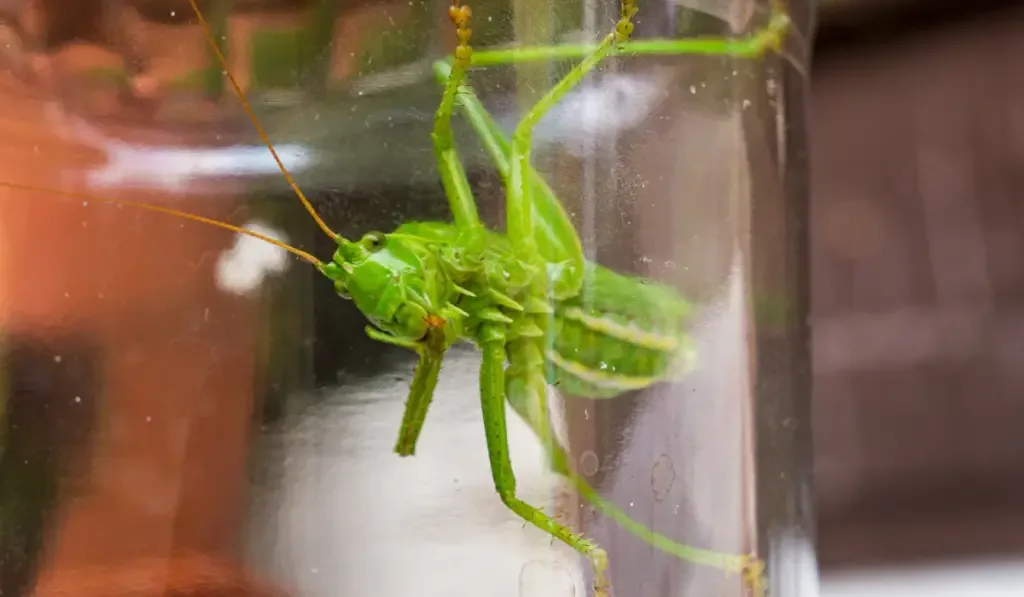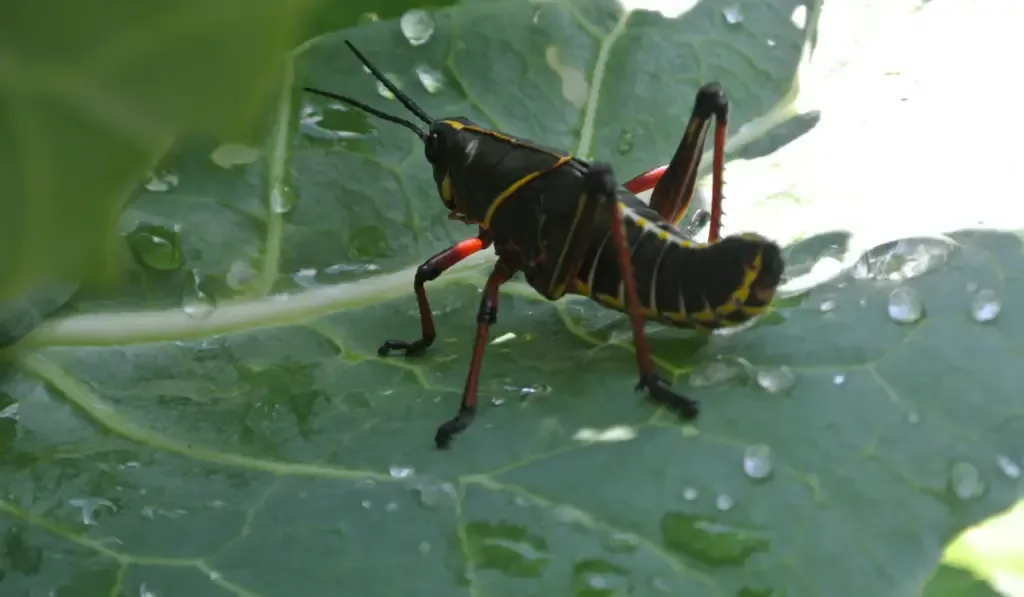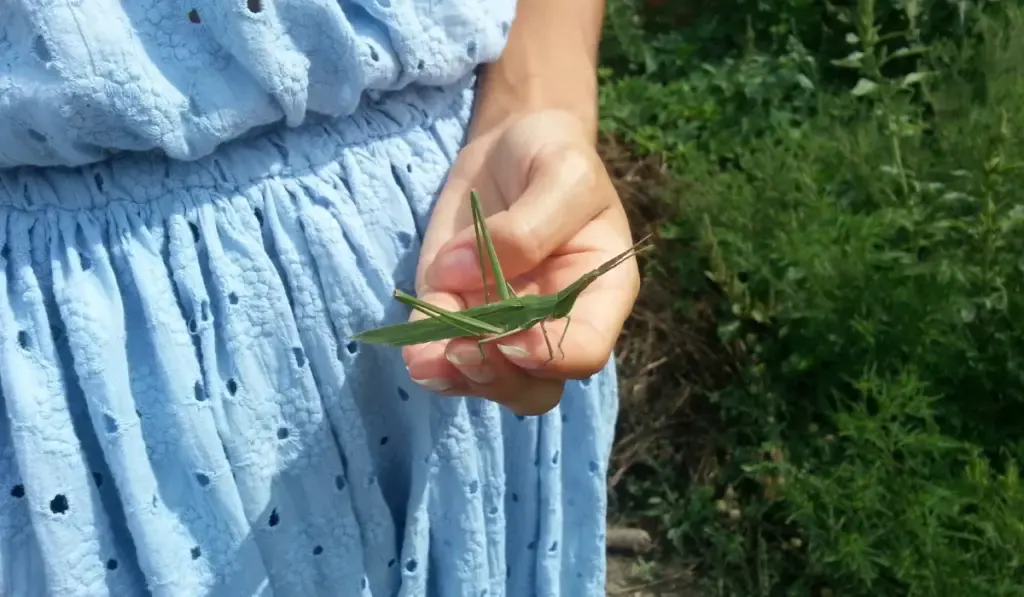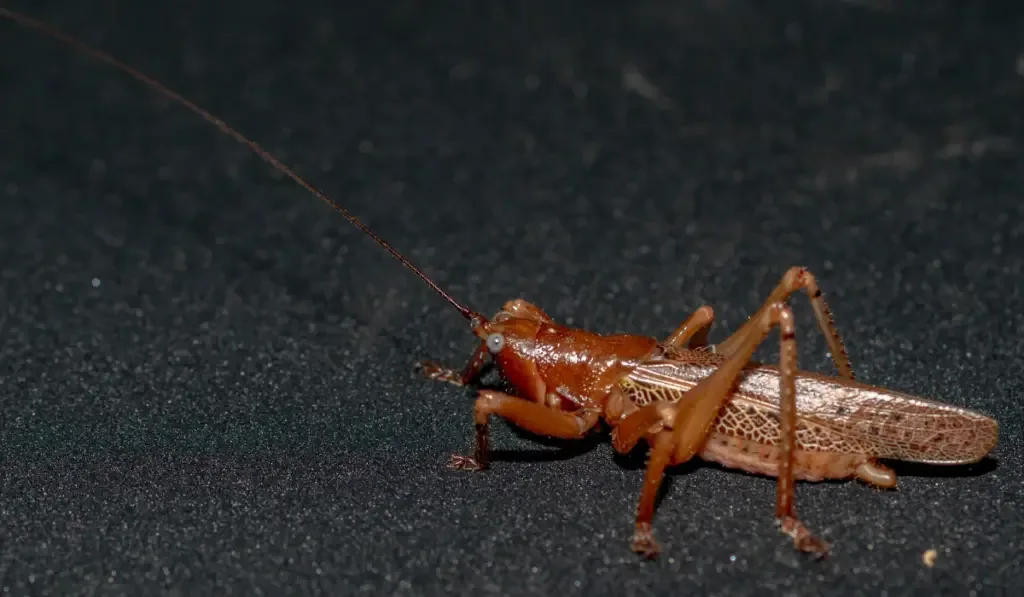Keeping grasshoppers is fun and easy. It does not matter what your intentions are for your grasshoppers, there are some basic care steps that you should abide by.
Table of Contents
Here are seven ways to care for your grasshoppers:
1. Get a Large and Clear Glass/Plastic Container for Your Grasshoppers

You are going to want to be able to see your grasshoppers, so you should go for a transparent container. You should use plastic or glass containers as your grasshopper terrarium or cage.
The terrarium should be large enough (according to the size of your grasshopper species) to allow your grasshoppers to jump freely. Most grasshopper terrariums are 5-10 gallons.
Note that grasshoppers can chew fabric and other similar materials, so keeping them in a mesh container can enable them to escape.
2. Feed Your Grasshoppers with Grasses and Leaves
Grasshoppers eat grasses and leaves. In the wild, grasshoppers can be destructive to your garden plants and flowers. In their terrarium, you get to decide what they eat.
Grasshoppers can eat almost every variety of grass and are not very selective. Grasshoppers will choose not to eat a leaf they find poisonous, so take note of leaves that your grasshoppers reject.
Raise your grasshoppers on an herbivorous diet. Leaves, grasses, flowers, seeds, etc. are part of their natural diet.
3. Spray Leaves and Grasses with Water Droplets before Feeding the Grasshoppers

Take note of this tip as many people kill their grasshoppers when they make mistakes related to giving them water. Grasshoppers do not enjoy a very humid terrarium and high humidity can kill them. Grasshoppers do, however, need water to stay alive.
To give water to grasshoppers, do not place a watering point in their terrarium. You should also not spray your grasshoppers directly with water.
To give them water, spray their food with water before placing the food in the terrarium. This method ensures that you are not giving them too much water that can harm them.
4. Remove Debris and Poop from the Terrarium
Since the terrarium can become highly humid quickly, it is not safe to leave decomposing food or debris in it for long. It can encourage the growth of decomposing fungi, and bacteria, and in turn, permit the growth of harmful microbes.
To prevent harmful microbes from sharing the terrarium with your grasshoppers, you should remove any uneaten grass or anything that is decomposing.
5. Do Not Expose Your Grasshoppers to Insecticides
If your grasshopper terrarium is in a room, do not use insecticides in that room. Also, when cleaning the terrarium, do not use chemicals that can kill insects.
Insecticides kill grasshoppers, so you should be very careful when using insecticides in a house with grasshoppers.
6. Only Keep Male and Female Grasshoppers in the Same Terrarium if You Want Them to Breed

Grasshoppers breed quickly to maintain the growth of their population. If you do not want more grasshoppers than you planned for, you should not keep males and females in the same terrarium.
You can identify the sex of grasshoppers by their size, color, and other features. Female grasshoppers are relatively bigger than their male counterparts. Male grasshoppers, however, have fairly brighter coloration than females.
If you examine the abdomen of your grasshoppers, you will find 2-4 sharp points at the end of the female grasshopper’s abdomen. Male grasshoppers have a round or smooth abdomen.
7. Keep Fewer Males in a Little Terrarium
Do not raise more than three males in a terrarium unless you have enough space, food, and mates for them. Grasshoppers can fight when the resources (or their needs) in the terrarium are limited.

Preparing Your Grasshopper Terrarium
You can easily get a terrarium suitable for grasshoppers in a pet shop. To make one yourself, get a clear and large plastic or glass container and follow the steps below:
- Pour Sand at the Bottom of the Terrarium: Sand is important in terrariums. Aside from making the container look more natural, it can help absorb grasshopper waste and permit the growth of plants that your grasshoppers can eat. The terrarium should have at least 2-3 inches of sand at the bottom.
- Place Twigs and Sticks in the Terrarium: Your grasshoppers will need sticks and twigs to sit and perch on. Place lots branches, sticks, and twigs in your grasshopper terrarium. Your grasshoppers would love them.
- Light and Temperature: The recommended temperature in your grasshopper terrarium ranges from 77°f to 95°f (25°c to 35°c). Too much heat from sunlight can kill your grasshoppers, so you should not place your grasshopper terrarium in a location with more than 4 hours of direct sunlight (especially mid-day sunlight).
Remember that the terrarium is the home of your grasshoppers, so you want to make their home as comfortable as you can for them.

Why You Should Raise Grasshoppers
In case you are looking for some good reasons to raise grasshoppers, we made a list for you!
1. As Pets
With their pretty colors and athletic performance, you will enjoy watching your grasshoppers hop and move about their enclosures. People raise grasshoppers as pets to view to forget about their boredom and even sadness.
2. As Treats for Your Pets and Farm Animals
A lot of household pets enjoy eating bugs. Giving your omnivorous pet grasshopper treats will make them very happy. Since they love grasshoppers, you can raise some grasshoppers to give to them as treats.
You can also buy some treats from a pet shop for your pets if you cannot raise grasshoppers.
3. For Food (Entomophagy)
Do you know that you can eat grasshoppers? Nutritionists encourage entomophagy as insects offer a lot of nutrients and insect consumption cannot harm your health. Insects such as grasshoppers are crispy and have a lot of proteins.
Why not raise grasshoppers to eat?
Related Questions and Answers
1. How And Where Can You Find Grasshoppers?
You will find grasshoppers in places where there are grasses. The taller the grasses, the higher your chances of finding grasshoppers.
In the fall, you will likely find grasshoppers hanging on the tips of grass blades. You can also get grasshoppers from pet shops.
2. What is the Lifecycle of a Grasshopper?
In the wild, grasshoppers live for a few weeks as a lot of animals eat grasshoppers as food.
In the terrarium, your grasshoppers can live for months as they have no predators and you give them enough to eat.
Grasshoppers do not undergo metamorphosis, so their young (nymph) look just like the adults.
3. Why Are Your Grasshoppers Becoming Brown?

There are over 10,000 species of grasshoppers and some species change their color according to the color of their food. When the color of your grass blades changes from green to brown (according to the season), some grasshopper species can change their color to brown as well.
Changing their color to brown can help hide your grasshoppers from predators, so changing their colors is a form of camouflage.
4. Why Are Your Grasshoppers Dying?
If your grasshoppers are dying, it could be one of the following reasons:
- Insecticides: Did you spray insecticides in your home recently? It could be the cause.
- High Heat or Humidity: If you placed the terrarium in a location with too much access to sunlight, your grasshoppers may die. Also, remember not to spray water droplets directly into the terrarium as the droplets can increase the humidity of the terrarium.
- Lack of food: You should give vegetables, grasses, and other plant products to your grasshoppers. If your grasshoppers are not eating their food, give them other types of grasses and leaves.
Remember to give fresh leaves to your grasshoppers. Do not give them leaves sprayed with insecticides.
5. What Other Insects Can You Raise?
Other insects that you can raise are:
- Praying mantises
- Mealworms
- Ants
- Bees
- Ladybug Beetles
- Crickets
- Silkworm moths
There are many insects that you can raise in your home if you want.
Final Thoughts
Raising grasshoppers is easy so long as you are careful and you abide by the tips above.
Remember to spray the grass and leaves you are giving to your grasshoppers with water droplets.
Do not place the terrarium in a location with high heat and humidity.
